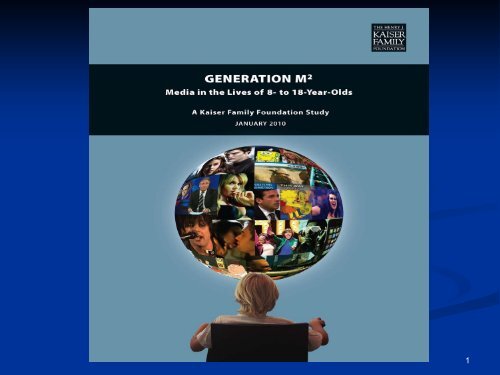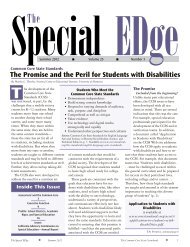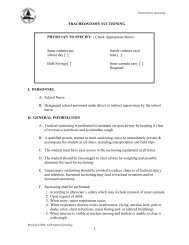Cyber Bullying Presentation
Cyber Bullying Presentation
Cyber Bullying Presentation
You also want an ePaper? Increase the reach of your titles
YUMPU automatically turns print PDFs into web optimized ePapers that Google loves.
8-18 year olds average<br />
Computer Usage Per Day…<br />
22 minutes social networking<br />
17 minutes play games<br />
11 minutes instant messaging<br />
15 minutes visiting Video web sites (YouTube)<br />
5 minutes Email<br />
4 minutes use graphics programs<br />
1 hour 2 minutes of total recreational use<br />
2
8-18 year olds average<br />
Cell Phone Usage Per Day…<br />
� 33 minutes talking<br />
� 1 hour 35 minutes texting<br />
“Text Messaging. In a typical day, 46% of 8- to 18-year-olds report sending text<br />
messages on a cell phone. Those who do text estimate that they send an average<br />
of 118 messages in a typical day. On average, 7th–12 th graders report spending about an<br />
hour and a half (1:35) engaged in sending and receiving texts.<br />
Rules. Relatively few 7th–12th graders say their parents have established any rules about<br />
talking or texting on a cell phone: 27% report that they have rules about the amount<br />
of time they can spend talking on the phone and 14% say they have rules about the<br />
number of texts they are allowed to send.”<br />
Kaiser Family Foundation – 2010<br />
3
8-18 year olds average<br />
% Say They Have Rules for Usage of…<br />
Music<br />
Video Games<br />
TV<br />
Computer Use<br />
0 10 20 30 40 50 60<br />
“Overall, 16% of all 8- to 18-year-olds say they don’t have any of the rules about<br />
content or amount of time spent with media asked about in the survey. About one in<br />
four (26%) report having at least some media rules, and also say their parents generally<br />
enforce those rules most of the time. The largest group of young people (39%) report<br />
having some rules regarding their media use, but say those rules aren’t always<br />
enforced.”<br />
Kaiser Family Foundation – 2010<br />
4
% of students ages 12–18 who reported being bullied<br />
at school and cyber-bullied: 2007<br />
Unwanted<br />
contact on<br />
internet<br />
Hurtful<br />
information on<br />
Internet<br />
Tota cyber<br />
bullying<br />
0.0 1.0 2.0 3.0 4.0 5.0 6.0<br />
National Center for Educational Statistics – Indicators of School<br />
Crime and Safety (2009)<br />
Female<br />
Male<br />
Total<br />
5
Texting - Instant Messenger<br />
<strong>Bullying</strong><br />
Girls are the primary offenders and victims.<br />
Girls mature more quickly than do boys.<br />
Girls use the internet as a secondary playground to<br />
socialize.<br />
Along with this socializing, comes bullying<br />
“Outcasts” can be excluded from chat rooms, booted<br />
from private chat rooms.<br />
“Don’t talk to Janie.” “Let’s all go to another area,<br />
Janie you can’t come.”<br />
The Ignore feature….”Iggy Button”<br />
6
<strong>Cyber</strong>bullying<br />
The New Adolescent Aggression<br />
“Being bullied besides over the Internet is worse.<br />
It’s torment and hurts. They say sticks and stones<br />
may break my bones but words will never hurt me.<br />
That quote is a lie and I don’t believe in it. Sticks<br />
and stones may cause nasty cuts but those cuts<br />
and scars will heal. Insultive words hurt and<br />
sometimes takes forever to heal.”<br />
- 14 year-old girl from New Jersey
<strong>Cyber</strong>bullying<br />
Is the willful and repeated harm<br />
inflicted through the use of computers,<br />
cell phones, and other electronic<br />
devices.
Issues Specific to <strong>Cyber</strong>bullying
Anonymity and Pseudonymity<br />
� Remain “virtually” anonymous<br />
� Temporary e-mail accounts and pseudonyms in chat<br />
rooms, instant messaging program<br />
� Disinhibition<br />
� Makes it very difficult for adolescents to determine<br />
the identity of their aggressors<br />
� Freed from constraints of behavior
� Lack of Supervision<br />
� Viral Nature<br />
� Text messages can be sent from one electronic<br />
device to a limitless # of recipients in a matter of<br />
seconds<br />
� Limitless Victimization
Mediums Through Which<br />
<strong>Cyber</strong>bullying Occurs<br />
� E-mail (earliest form of cyberbullying)<br />
� Chat Rooms<br />
� Voting/Rating Web Sites<br />
� Babe vs. Babe<br />
� Pick the Hottie<br />
� Hot or Not
Mediums continued…<br />
� Blogging Sites, Virtual Worlds, and Online Gaming<br />
� WordPress<br />
� Open Diary<br />
� Blogger<br />
� LiveJournal<br />
� frequent updates on their lives, experiences, perspectives, Posts of and interests<br />
� Cell Phones<br />
� Instant Messaging
Common Forms of <strong>Cyber</strong>bullying<br />
� Photoshopping<br />
� Rumor Spreading<br />
� Flaming and Trolling<br />
� Identity Theft/Impersonation<br />
� Physical Threats
� Angry<br />
Emotional Consequences of<br />
� Females<br />
� Frustrated<br />
� Sad<br />
� Females<br />
� Females<br />
� Embarrassed<br />
� Males<br />
� Scared<br />
� Males<br />
<strong>Cyber</strong>bullying
<strong>Cyber</strong>bullicide
Ryan Halligan<br />
December 18, 1989 – October 7, 2003<br />
17
Jeffrey Johnston<br />
1990 - 2005<br />
18
Megan Meier<br />
November 6, 1992 – October 17, 2006<br />
19
Phoebe Nora Mary Prince<br />
November 24, 1994 - January 14, 2010<br />
20
Social Networking Web Sites
� MySpace<br />
� 2003 - founded<br />
� Gained popularity among budding musicians who were<br />
looking for a place to promote their music.<br />
� Fans could keep in contact with artists for tour dates, etc.<br />
� As of 2008, 226 million accounts
� Facebook<br />
� 2004<br />
� 64 million active users<br />
� 250,000 new accounts created each day<br />
� Bebo<br />
� 40 million users<br />
� United Kingdom<br />
� Ireland, Canada, and Australia
� Orkut<br />
� Created by Google employees<br />
� 67 million users<br />
� Predominately in Brazil and India<br />
� Friendster<br />
� Over 50 million users<br />
� Asia<br />
� Xanga<br />
� 40 million users<br />
� Multimedia blogging
Preventing <strong>Cyber</strong>bullying<br />
� Districts should have clear policies on<br />
cyberbullying<br />
� Acceptable Use Policy (AUP) at schools<br />
� Teachers take time to discuss cyberbullying in<br />
their classrooms<br />
� Post guidelines near computer stations<br />
25
� Utilize the expertise of students through peer<br />
mentoring<br />
“Parents and teachers can get up and preach, but if they<br />
hear it from another kid, they will remember it.”<br />
- Parent from California<br />
26
Parents<br />
� Engage children in a dialogue about the relevant<br />
issues, venture into cyberspace with them<br />
� Formally or informally monitor their electronic<br />
devices<br />
� Internet Use Contract<br />
� Cell Phone Contract<br />
� Communication is the…………..<br />
27
Students<br />
� Never give out personal information<br />
� Keep password private. Do not tell other<br />
friends<br />
� Remember that photos, videos, and text cannot<br />
easily be easily deleted.<br />
� Talk to your parents<br />
28
Responding to <strong>Cyber</strong>bullying<br />
29
Schools<br />
� Assess the immediate threat<br />
� Ensure the safety of the target<br />
� Demonstrate compassion and empathy to the<br />
target<br />
� Restrain the bully if necessary (separate from<br />
target; closely monitor)<br />
� Investigate and gather evidence<br />
30
Schools Continued….<br />
� Contact parents<br />
� Contact Internet service provider<br />
� Enforce disciplinary policy<br />
� Contact police when physical threats are<br />
involved<br />
� Contact legal counsel if considering serious<br />
disciplinary action<br />
31
Parents<br />
� Make sure child is and remains safe<br />
� Collect evidence<br />
� Contact school<br />
� Contact the parents of the offender<br />
� Contact the service provider or content provider<br />
� Contact the police when physical threats are<br />
involved<br />
32
Parents whose child is the<br />
<strong>Cyber</strong>bully<br />
� Talk about the hurtful nature of bullying<br />
� Apply reasonable consequences<br />
� Set firm limits and stick to them<br />
� Consider installing tracking software<br />
� Closely monitor computer/cell phone usage<br />
� Convey firmer consequences if the behavior<br />
continues<br />
33
Youth<br />
� Document what they see and when<br />
� Don’t encourage the behavior<br />
� Don’t forward hurtful messages<br />
� Don’t laugh at inappropriate jokes<br />
� Don’t condone the act just to fit in<br />
� Don’t silently allow it to continue<br />
� Stand up for the victim<br />
� Tell an adult they trust<br />
34
Youth who are <strong>Cyber</strong>bullied<br />
� Ignore minor teasing or name calling<br />
� Block messages from unknown people<br />
� Don’t respond to the bully<br />
� Keep a log/journal of attacks<br />
� Keep all evidence of bullying<br />
� Talk to an adult they trust<br />
35
Thank you for your time<br />
?????<br />
Christine Laehle, MPH<br />
Program Specialist, OCDE<br />
714-327-1067<br />
claehle@ocde.us<br />
36

















